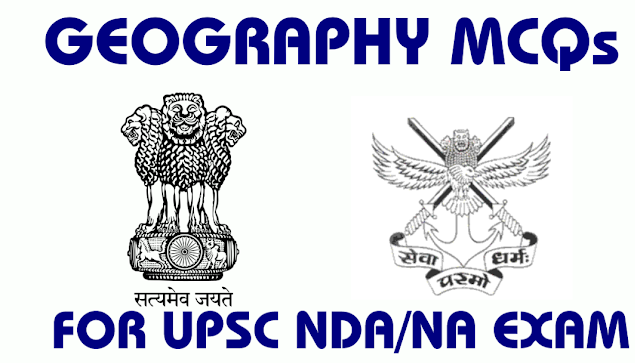Geography MCQs For UPSC(NDA/NA) Exam
UPSC NDA/NA GEOGRAPHY MCQ Q.1
Which one of the following countries was least affected by the tsunami that hit the Indonesian Ocean on 26th December,2004?
(a) Indonesia
(b) Malaysia
(c) Sri Lanka
(d) India
Ans.(b)
UPSC NDA/NA GEOGRAPHY MCQ Q.2
Humid climate, ready market, and availability of cheap and skilled labour are the conditions conducive for the production of cotton cloth. Which of the following states of India will have the highest cotton cloth production?
(a) Gujarat
(b) Karnataka
(c) Maharashtra
(d) Punjab
Ans.(a)
The top 5 states with the highest cotton cloth production.
1. Gujarat
2. Maharashtra
3. Andhra Pradesh
4. Punjab
5. Haryana
UPSC NDA/NA GEOGRAPHY MCQ Q.3
The requirement for water is highest in which one of the following industries?
(a) Iron and steel
(b) Oil refining
(c) Paper from wood
(d) Rayon
ANS.(A)
UPSC NDA/NA GEOGRAPHY MCQ Q.4
In India, an increase in population and diversion of agricultural land for non-agricultural purposes have resulted in a decrease of..
(a) forested land
(b) cultivable wasteland
(c) net shown area.
(d) double cropped area.
Ans.(c)
UPSC NDA/NA GEOGRAPHY MCQ Q.5
Radioactive decay provides an internal source of heat for the Earth. This helps in the formation of which type of rocks?
(a) Igneous
(b) Sedimentary
(c) Metamorphic
(d) All of the above.
Ans.(d)
UPSC NDA/NA GEOGRAPHY MCQ Q.6
The greatest seasonal contrast of insolation on the Earth is in which of the following latitudinal zones?
(a) Equatorial
(b) Tropical
(c) Temperature
(d) Polar
Ans : (d)
UPSC NDA/NA GEOGRAPHY MCQ Q.7
Which one among the following rocks does not belong to the same group?
(a) Shale
(b) Limestone
(c) Slate
(d) Sandstone
Ans.(c)
UPSC NDA/NA GEOGRAPHY MCQ Q.8
The Deccan Trap Formation was caused by..
(a) shield eruption
(b) composite eruption
(c) caldera eruption
(d) flood basalt eruption
Ans.(d)
UPSC NDA/NA GEOGRAPHY MCQ Q.9
A wide range and variability in rainfall, torrential in character, reversal of winds, and uncertain arrival are the characteristics of
(a) westerlies
(b) trade winds
(c) monsoon
(d) antitrade winds
Ans.(a)
Westerlies are prevailing winds in the middle latitudes between 30 degrees and 60 degrees latitude, blowing from the high-pressure area in the horse latitudes towards the poles. These winds blow from the west to the east and steer extratropical cyclones in this general manner.
UPSC NDA/NA GEOGRAPHY MCQ Q.10
Mackerel sky is associated with cloud type -
(a) cumulo-nimbus
(b) strato-cumulus
(c) alto-cumulus
(d) cirro-cumulus.
Ans(d)
A 'Mackerel Sky' or 'buttermilk sky' is an indicator of moisture (the cloud) and instability (the cirrus-cumulus form) at intermediate levels ( 2400-6100 m, 8000-20000 ft).







![[VSQ]MAJOR PEST & DISEASE OF RICE, WHEAT, COTTON, CHICKPEA, SUGARCANE, & THEIR MANAGEMENT, Set 4](https://blogger.googleusercontent.com/img/a/AVvXsEhF_vee7QvzlzE2SRms1uOhc6OllrxtDYj9sLJ7B2X2rCHpARU4ObdPvQN4URvBjY9wwGGJO3zz5tBG0uxtbrvsYdJT-msQ8dOKeWJh4EMBNPn-OV_BpvCOrwYe22_b4R8_ZpOtr9-0GC96_eZGaA-1WWoSV7GtKrW23CpeuxycC0gG6jaIaL-mN_0Y=w680)

![[VSQ]SOIL SCIENCE, SET 8](https://blogger.googleusercontent.com/img/a/AVvXsEiu2pwbUlJhWzxQAUfU0wsfYm7NpHO3qwDQD8GjSVFNRy3kErigGn8AFCXHzYlLfbIjkU1ooQ7KxV2yrh_Ogw6VsHqm61MbUszsGEu-BpIB0ZSjgoTjP9iGwIH4Xq4U8qSG9-52qvVIPbPoVmTAgc7QE4GHOvIdJGEby3QC7tk0p56XNBlcSnMwr0YO=w680)



0 Comments